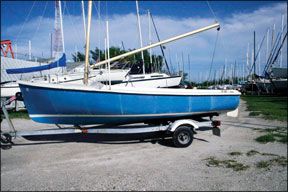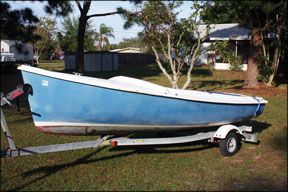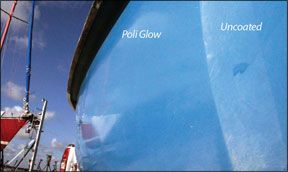The search for shortcuts to a shiny hull ends here at Practical Sailor, and while weve yet to find any “miracle” products, new technology is making boat maintenance chores easier.
Our July 2009 issue compared 26 bottled waxes and gave an update on our test of 10 traditional paste waxes. This month, we offer a one-year checkup on an alternative approach to restoring and preserving a shiny gelcoat: acrylic coatings.

Acrylic coatings differ significantly from ordinary bottled or paste waxes in both their chemistry and how they are applied. Conventional carnauba paste waxes (those made from the carnauba bean) mechanically stick to the surface of the hull and usually require rubbing to get them to crystallize and shine. Buffing drives the wax into the surface pores.
Synthetic polymer “waxes” penetrate pores and chemically bond to the boats surface. Some synthetics resist abrasion and chemicals better than true waxes, but the line between conventional waxes and polymer waxes is fuzzy. Even products that are advertised as true carnauba waxes often rely on polymer technology.
Another term that leads to confusion is the word “polish,” which is frequently applied to two distinct products-those that smooth surface defects with a mild abrasive and those with no abrasives that serve as the final gloss coating. For clarity, Practical Sailor refers to a product as a polish if it actually polishes the surface with an abrasive. We generally refer to abrasive products as rubbing compounds, finishing compounds, or micro-finishing compounds. If it has no abrasives, it is a wax, or polymer finish. Some products are a little of both. For instance one-step cleaner waxes are hybrid blends that both contain a mild abrasive and a polymer or wax finish. (See “Boat Polish Test: One-Step Cleaner/Waxes,” March 2007.)
Like most of the bottle- and paste-wax products in the July 2009 test, the acrylics featured here contain no abrasives and are meant to be the final coat applied to a finely polished hull. They are designed to fill surface pores and provide a thin protective coating to give the gelcoat a smooth, shiny appearance.

Acrylics are applied differently than most waxes. With acrylics, multiple thin coatings (up to eight) are “painted” on to provide a smooth overall finish. There is no rubbing or buffing. Like polymer waxes, acrylics bond to the surface and are very resistant to abrasion, weathering, and chemical attack. Acrylics are harder to touch up than waxes; this can be a problem on a boat that sees a lot of bumps from fenders and pilings.
Acrylics are formulated to fill the deeper pores youd find on older, severely oxidized hulls beyond the help of conventional waxes. Acrylic coatings are more expensive and more difficult to apply (and remove) than waxes, so using them on a new hull that is easily brought to a gleaming finish with conventional waxes is not cost effective. For this reason, Practical Sailor does not recommend acrylics for newer boats with good gelcoats. (However, some Practical Sailor readers prefer using acrylics on new hulls, saying they last longer and prevent waterline stains better than the waxes.) We also do not recommend using an acrylic on surfaces that may be painted the following year.
What We Tested
Practical Sailor
What We Tested
For this comparison, we tracked down seven products, including repeat contenders Vertglas from Lovett Marine, Poli Glow, and NewGlass2. New to our tests were Star brite Glass Cote, Klasse High Gloss Sealant Glaze, Higley FiberGloss Restorer, and Presto Gelcoat Rejuvenator.
Some restorer products are sold in a kit, while others are just one bottle. For instance, Vertglas includes an applicator, a heavy-duty oxidation remover, a boat wash, a restorer/sealer, and a cleaner to remove the restorer/sealer. Kits for Poli Glow and NewGlass2 also come with a pre-treatment cleaner. A couple of the other manufacturers sell cleaners separately. (Poli Glow has a new remover that we will be testing.)
All of these products require five to eight coats and must be reapplied annually or at least every two years. The more exposure to weather-especially sunlight-the quicker they wear. Poli Glow, for example, recommends reapplying at the six- to eight-month mark in tropical climates.
There have been reports of acrylic coatings yellowing or peeling. Through the course of many tests over the years, Practical Sailor has not witnessed yellowing in any of our recommended products. We have found that some of these products will start peeling away if they are not re-coated within their prescribed period. Weve also heard that some household cleaners will cause peeling, so as in the case of a waxed hull, use only mild, Ph-balanced soaps (most boat soaps qualify) for cleaning.
How We Tested
Following the manufacturers directions, testers applied the products to taped-off segments of our test boat, a 1974 Oday Javelin. The port side of the hull was not wet-sanded or compounded prior to finishing, something that we highly recommend for someone who wants the best results. (If you are going to use a finishing compound to polish the hull, check with the maker of the acrylic finish first. Most recommend only water-based finishing compounds, and several insist on using their own hull cleaner.) Instead, we followed the makers instructions for surface prep.

All of the top-rated products (see Value Guide above) called for the use of a dedicated hull cleaner to prepare the surface. After each product was applied to the port side and rated for gloss, testers applied the highest rated products to the starboard side.
The starboard hull was wet-sanded (800 grit) and polished with a micro-finishing compound, and the outcome was significantly better. One section of the starboard hull was waxed with Collinite 885, our best performing paste wax in our most recent test.
At regular intervals, ratings for gloss and color retention were carried out independently by three observers.
Conclusion
At the one-year mark, three products stood out with superior performance: Poli Glow, one of the more expensive products tested, had the glossiest surface and slightly better color retention than NewGlass2. The Vertglas had the best color retention and only slightly less gloss than Poli Glow. NewGlass2 and Vertglas were neck and neck in terms of gloss, just slightly behind Poli Glow. The others did no better than our paste wax.
For those who like the idea of an acrylic finish, Practical Sailor recommends any of the top-rated products. Poli Glow edges ahead for its gloss, instructions, kit materials, and customer support. Performance-wise they are all very close after one year.
has tested acrylic coatings many times in the past. After three years, when we finally called it quits on our most recent long-term test, Poli Glow was the last man standing and still retained a surprising amount of gloss. This test involves more products than weve ever tested and adds another twist: a blue hull, rather than our usual white; the blue shows even mild oxidation.


































